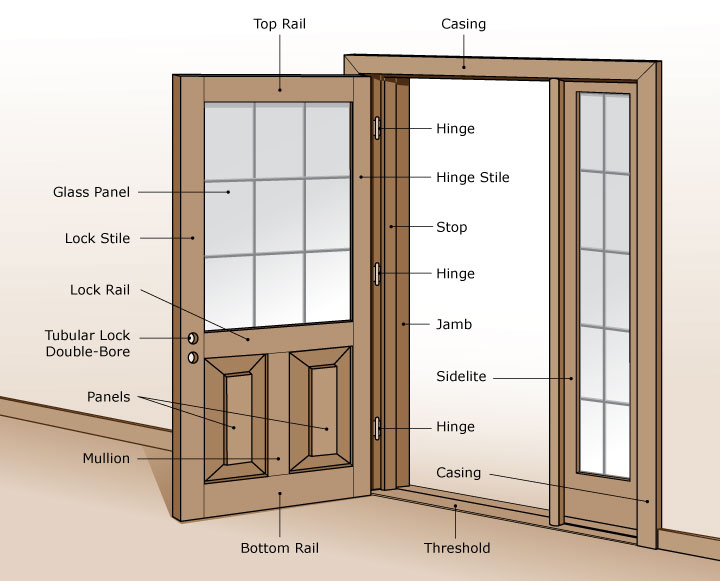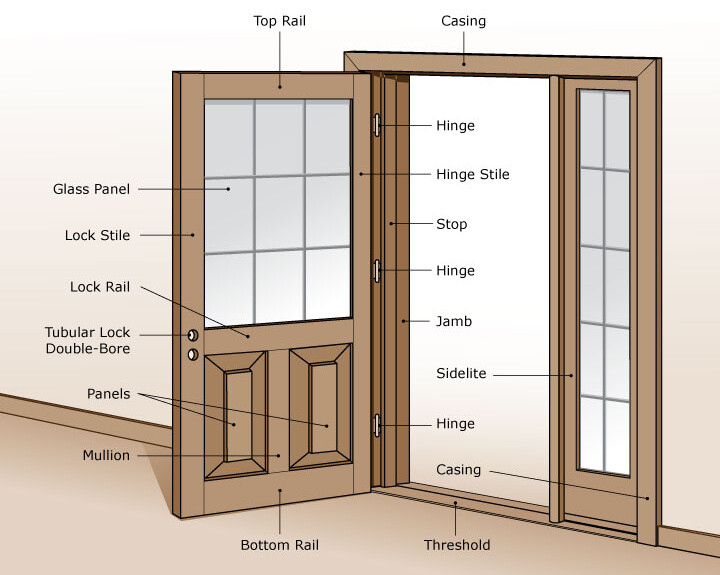Doors are essential to any building or structure, providing privacy, security, and protection from the elements. However, without the proper support and framework, doors can become unstable and may not function as intended. It is where door jambs come into play. Door jambs provide a sturdy framework for the door, ensuring it remains in place and operates smoothly.
In this article, we will talk about the components of a door jamb, why choosing the appropriate one is crucial, and what advantages effective installation offers.
Also read: 14 Standard Room Sizes for Bedroom
What is Door Jamb?
The door is often the first line of defense when securing your home. But have you ever stopped to think about what keeps the door in place and functioning properly? The answer lies in the door jamb, a crucial component of any door frame.
A door jamb is the vertical portion of the door frame that provides a support structure for the door itself. It consists of two upright pieces, one on each side of the door and a horizontal piece called the head jamb that connects the two vertical pieces at the top of the door frame.

The door jamb is essential for keeping the door in place, as it provides a secure attachment point for the hinges that allow the door to swing open and closed. Additionally, the door jamb helps keep the frame straight and true, preventing the door from warping or twisting over time. In this way, the door jamb plays a critical role in ensuring the security and durability of your door.
What are the Parts of A Door?
Now that we have a basic understanding of what a door jamb is and its importance let’s take a closer look at its parts.
A door jamb comprises two vertical pieces, one located on each side of the door. These vertical pieces are typically made from the same material as the door frame, such as wood, steel, or composite materials. The vertical pieces of the door jamb provided the main support structure for the door, allowing it to swing open and close.

At the top of the door jamb, you’ll find a horizontal piece called the head jamb. This piece connects the two vertical pieces at the top of the door frame and provides additional support for the door. Like the vertical pieces, the head jamb is typically made from the same material as the door frame.
Together, these parts form the door jamb and provide the essential support structure for the door. The materials used for the door jamb and its components can vary depending on cost, durability, and ease of maintenance. When selecting a door jamb, it’s important to consider these factors and choose a material that meets your specific needs.
Also read: What is Standard Bedroom Sizes?
What is the Role of a Door Jamb?
The door jamb serves multiple important purposes when it comes to ensuring your door’s proper operation and longevity.
Firstly, the door jamb is responsible for keeping the door in place. The two vertical pieces of the door jamb provide the main support structure for the door, keeping it upright and preventing it from falling out of the frame.
The door jamb is particularly important for exterior doors, subject to weather conditions and other environmental factors that can cause the door to shift or become misaligned over time.

Secondly, the door jamb provided a secure attachment point for the hinges, allowing the door to open and close. The hinges are screwed into the door jamb, which provides a sturdy and reliable anchor point for them. It is particularly important for heavy or frequently used doors, such as those in commercial or industrial settings.
A secure attachment point helps to prevent the hinges from becoming loose or detached, which could result in the door becoming unstable or even falling out of the frame entirely.
Finally, the door jamb helps to keep the door frame straight and true. Over time, doors can become warped or twisted due to changes in temperature and humidity. The door jamb provides a rigid and stable framework that helps prevent these issues.
Additionally, the head jamb provides additional support and stability to the top of the door frame, which can help to prevent sagging or shifting over time.
Also read: 17 Different Types of Walls
How to Select a Door Jamb?
When selecting a door jamb, several factors must be considered to ensure that you choose a product that meets your specific needs. One of the most important factors to consider is the material of the door jamb. Several options are available, each with unique advantages and disadvantages.
Wood is a popular choice for door jambs thanks to its durability, natural beauty, and ease of customization. Wood jambs can be stained or painted to match your home’s decor and easily be repaired if damaged. However, wood is also susceptible to rot and insect damage and may require regular maintenance to keep it in good condition.
Steel is another popular choice for door jambs, particularly in commercial and industrial settings. Steel jambs are extremely durable and provide excellent security and resistance to forced entry. They are also highly fire-resistant and can help to prevent the spread of flames in the event of a fire. However, steel jambs can be more expensive than other materials and may require professional installation.
Composite materials, such as PVC or fiberglass, are becoming increasingly popular for door jambs. These materials are highly durable and resistant to weathering, rot, and insect damage. They are also highly customizable and can be made to look like natural wood. Composite jambs can be more expensive than other options but are generally less expensive than steel jambs.
Another factor to consider when selecting a door jamb is size and thickness. The size and thickness of the door jamb should be appropriate for the size and weight of the door itself. A too-thin or too-small jamb may not provide adequate support, while a too-large or thick jamb may be difficult to install or not fit properly in the door frame.
How to Install a Door Jamb?
Installing a door jamb is critical to ensuring the door functions properly and provides adequate support and security. There are several reasons why proper installation is so important.
Firstly, proper installation ensures that the door jamb provides adequate support for the door. If the jamb is not installed correctly, it may be loose or unstable, which can cause the door to sag or shift over time. It can lead to issues with the door’s operation, such as difficulty opening or closing gaps that allow air or moisture to enter the home.
Secondly, improper installation can lead to problems with the door’s operation. If the jamb is not installed correctly, it may be too tight or too loose, which can cause the door to bind or stick when opening or closing. It can lead to frustration and inconvenience and may require costly repairs or door jamb replacement.
Additionally, improper installation can compromise the security of the door. If the jamb is not securely anchored to the frame, it may be vulnerable to forced entry. It can pose a significant safety risk to the occupants of the home or building and may result in theft or property damage.
FAQs
-
What is a door jamb?
A door jamb is a vertical frame that surrounds the door and provides support and stability to the door.
-
What materials are door jambs made of?
Door jambs can be made of various materials, including wood, steel, and composite materials. The choice of material often depends on factors such as the door’s weight, size, and desired level of security.
-
Why is a door jamb’s proper size and thickness important?
A door jamb’s proper size and thickness are important because they ensure that the door is adequately supported and remains in place. If the jamb is too small or thin, it may not provide enough support for the door, leading to sagging or shifting over time.
-
What is the purpose of a head jamb?
The head jamb is a horizontal piece that connects the two vertical pieces of the door jamb. Its purpose is to provide additional support and stability to the door, as well as to distribute the weight of the door evenly across the frame.
-
Do I need a professional to install a door jamb?
While it is possible to install a door jamb yourself, it is recommended to hire a professional contractor to ensure that the installation is done correctly. Proper installation is critical to ensure the door operates smoothly and provides reliable security.
A professional can also help you choose the right door jamb for your specific needs and ensure that it is installed promptly and efficiently.
Conclusion
In conclusion, door jambs are important in providing support, security, and durability for doors. A properly installed door jamb keeps the door in place, provides a secure attachment point for hinges, and keeps the door frame straight and true. When selecting a door jamb, it’s important to consider factors such as material, size, and compatibility with the door.
Additionally, proper installation is critical to ensuring that the door operates smoothly and provides reliable security. By choosing the right door jamb and installing it correctly, you can ensure that your door provides reliable performance and security for years to come.





